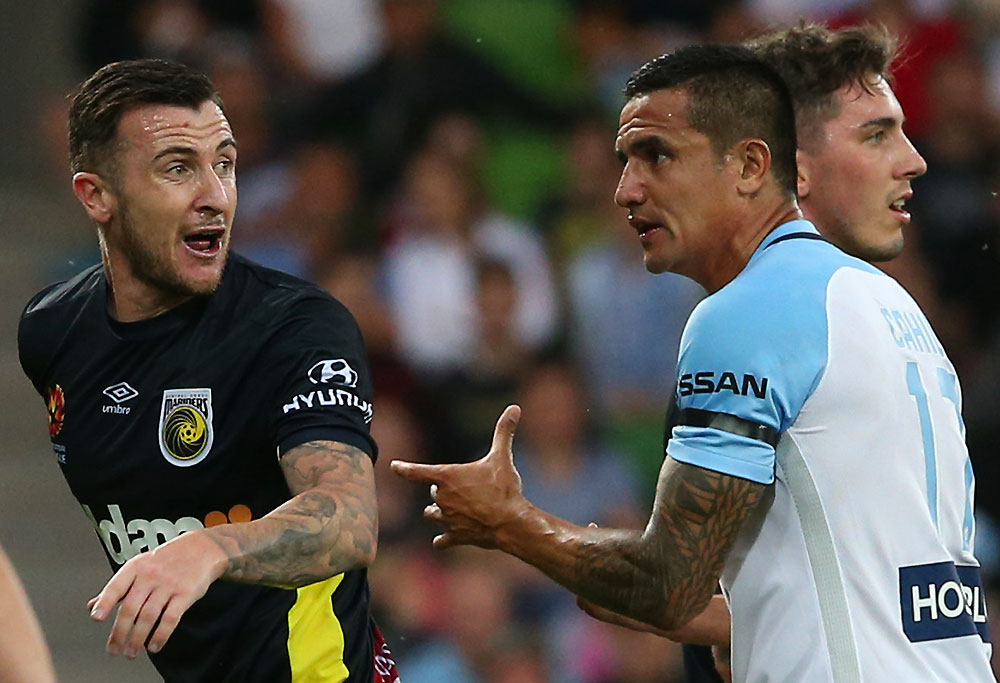In front of Manchester City executives, as well as Roy Hodgson, Ange Postecoglu, and less than 10,000 others, Melbourne City’s season ended with a weak parp. As the last few trumpets and trombones trailed off, the bandwagon finally eased creakily to a stop.
The season had begun so well, all horns blaring, the beginning of the true ascendance. It ended in front of a smattering of people, making good on the threat of anticlimax City had been teasing for the last few months.
“I can’t believe the season’s over, I honestly can’t,” Tim Cahill said.
His teammates, however, played in a manner that seemed to beckon to the dense silence of the off-season, devoid as they were of any bite or spritz. It was perhaps best exemplified in Diego Castro’s opening goal – an intensely Castro-esque cut inside and angled finish – to which they offered precious little bodily resistance.
The meandering haze that many people thought would be dissipated by the pressure of the finals obdurately remained, and Cahill’s surprise, with this in mind, seems a little surprising in itself.
Still, even though this season washed out disappointingly, this will not discourage the City Group’s fervour for the project. Manchester City took three years to win their first trophy of the petro-dollar era, and have since won two league titles and a league cup. Theirs has been a demonstrable example of how persistent, unprecedented financial investment, maintained over a large enough period, can’t help but bring with it on-field success.
Crucial to City’s rise, though, has been the ability to retain the talent brought in, slowly building it up, to the point now where they consistently have one of the Premier League’s deepest squads.
Retaining great players, season on season, is something all A-League clubs have a hard time doing. Melbourne City’s 2016-17 campaign has, for example, exposed the reliance Bruno Fornaroli had on Aaron Mooy and Harry Novillo. Fornaroli, in spite of his obvious brilliance, was unable to pick up the same working relationship with Mooy and Novillo’s replacements this season.

City can spend money – they will, in fact – every season, securing record-breaking marquees and high-profile managers, but if the squad loses as much talent every season as it gains, then progress will be hard to make.
Here is where the City Group’s exploitation of the loan system enters as a potential solution. We’ve already seen how effective it is in getting around the various fiscal restrictions A-League clubs have to act under – mainly, so far, those regarding the lack of transfer fees between A-League clubs – and the practice could yet be used to maintain squad strength.
At both Melbourne City and New York City FC players bought by Manchester City have been immediately loaned to these clubs. At the moment Luke Brattan and Anthony Caceres are on loan deals at Melbourne City from the Manchester franchise, both of which expire this season. Is there any reason, from the perspective of the City Group, that these players should not again go on loan to Melbourne?
In 2015, the FFA had to amend the rules regarding loan players at A-League clubs, when Tom Rogic and James Troisi’s loan deals with the Melbourne Victory did not incorporate the loan fees paid by the Victory to, respectively, Celtic and Juventus, into the salary cap. The rules were then changed to include such fees in cap calculations, or – if the fees are negligible – 50 per cent of the player’s salary at their parent club.
So, then, if Manchester City players are loaned without a fee to Melbourne City, the City Group are essentially orchestrating a situation where their Melbourne franchise can sign players potentially at a 50 per cent markdown, which is a huge salary cap advantage.
This isn’t even taking into account the fact that cap-exempt designated players – of which clubs can have two such contracts – have no ceiling on their salaries, or the fact that managers’ salaries have no cap to them. Roy Hodgson, as mentioned above, was taking a keen interest in the semi-final, and visited City’s training headquarters a few weeks ago. Michael Valkanis will not be made the permanent manager, and it’s difficult to see why Hodgson would be so involved where he not lined up to take the position himself.

Players who excel in the A-League, especially young ones, want to move abroad. City can now offer them salaries up to the margin of the cap to temper their youthful ambition and, if need be, sign them at Manchester City and loan them straight back to the A-League. They can offer playing opportunities in England, the US, and Japan, and have a massive scouting and development network. The City Group know what happens when the money flow is steady, and they have a bottomless reservoir of funds.
This season has not gone to plan for Melbourne City, pouring cold water on the the most anticipated campaign in the club’s history. The Roarcelona period aside, dynasties have been hard to build in the A-League, with the constant squad upheaval and season-to-season volatility tamping down would-be candidates.
But there has never been a club in City’s position, with their resources and support, and this season, deflating though it has been, should not cast doubt on their ability to, through pure tyranny of affluence, seize supremacy in the seasons to come.































































































